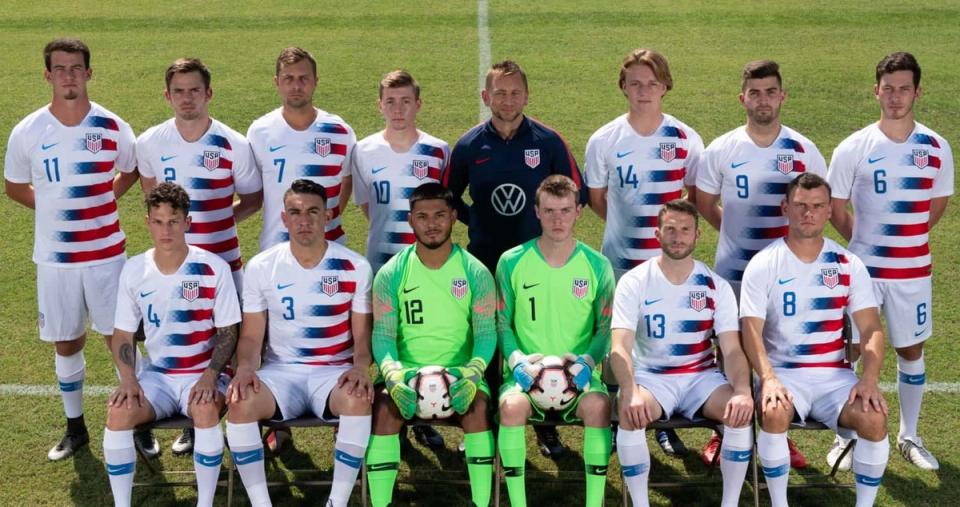2019 IFCPF World Cup Preview: U.S. Para 7-A-Side National Team Grouped With Iran, Finland and Ireland
16-Team World Cup Kicks off July 6 at Sevilla FC’s Training Center in Spain



July 8 vs Iran at 3 p.m. ET - U.S. Kicks Off World Cup with 3-2 Comeback Win
July 10 vs. Finland at 3:10 a.m. ET
July 12 vs. vs. Ireland at 1:10 p.m. ET
All matches will be played at the Ciuada Deportiva complex - the training center for La Liga club Sevilla FC - with select games streamed live on the Spanish Federation’s Youtube Page. Fans can follow along on twitter @ussoccer_pnt and Instagram at @ussoccer_pnt.
CLICK HERE FOR THE FULL SCHEDULE, RESULTS AND STANDINGS
Eleven players return from the 2018 Copa America team: Adam Ballou, Tyler Bennett, Andrew Bremer, Joshua Brunais, Jacob Crumbley, Cameron DeLillo, David Garza, Shea Hammond, Seth Jahn, Jacob Kaplan and Nick Mayhugh.
The team went 3-2 in at that tournament in Ecuador, defeating Venezuela, Ecuador and Colombia by a combined 19-2 margin, while suffering one-goal losses to Argentina (0-1) and Brazil (1-2). All eight goal-scorers from that team return for the World Cup: Mayhugh (6); Brunais and Hammond (3); Ballou, Bremer, Jahn (2); Crumbley and Kaplan.
Nine return also from the 2017 World Championships roster: Ballou, Bennett, Sean Boyle, Bremer, DeLillo, Garza, Jahn, Ben Lindau and Mayhugh.
The USA posted a 4-2 record in that tournament in Argentina – defeating Australia, Northern Ireland, Brazil and Ireland and falling to England (1-2) and eventual winners, Ukraine (0-2). The team outscored its opponents 18-8. This roster includes players who scored 16 of those 18 goals: DeLillo (6), Ballou (5), Jahn (2) and Bremer, Garza and Mayhugh.
The average age of the 2019 team is 23.5 years old: Five are teenagers: Hammond (17 years old), Crumbley (18), and Alvey, Kaplan, and DiLillo (all 19). Seven are in their 20s: Lindau (20), Mayhugh and Bremer (23), Boyle (24), Garza (26), and Ballou and Bennet (27). On the other end are Brunais (32) and Jahn (36).
Jahn, Brunais, and Garza are veterans of the U.S. Army.
Ballou enters the tournament as the team’s most experienced player on the international stage, having joined the program as a 14-year-old and competing in his first World Championship in 2009 and also 2011, 2015 and 2017, as well as the 2012 and 2016 Paralympics.
Bennett brings the second most international experience, with his first competition being the 2010 Copa America.
The Cerebral Palsy International Sports and Recreation Association (CPISRA) has long been the leading international sports entity governing and promoting participation in a number of sports for athletes with neurological conditions.
The first world championship of CP Football took place in 1982 as part of the CPISRA World Games in Greve, Denmark.
The first five CP football world champions – from 1984 through 1998 – were decided every four years, and since 2001 the winner has come from tournaments held biannually.
As CP Football continued to gain steam under the guidance of CPISRA, in 2015 the sport branched out with the creation of IFCPF to govern international soccer moving forward.
While the first 14 world champions were decided through competitions of various names, the 2019 World Cup is the first to carry the title commonly known in other soccer disciplines.
IFCPF has announced its intent to hold an IFCPF World Championships and IFCPF World Cup two years apart: “IFCPF implemented these titles to reflect the high performance level of these events and to support our members to secure funding to participate.”
The difference between the two biannual events is the qualification process and the resulting rankings for future competitions.
The 2019 World Cup’s Local Organizing Committee is the Spanish Cerebral Palsy Sports Federation (FEDPC - Federación Española de Deportes de Personas con Parálisis Cerebral y Daño Cerebral Adquirido).
The USA has been represented in 11 of the 14 previously contested tournaments, with its first appearance as one of five teams who participated at the 1990 CPISRA Soccer World Championships in the Netherlands.
The 2017 IFCPF World Championships held in Argentina saw the U.S. Para 7-a-side NT finish 5th in the 16-team field, marking the program’s best finish at a world championship in the modern era of the sport.
The 2019 World Cup marks the USA’s 10th straight finals.
Featuring 16 of the world’s top Para 7-a-side teams, eight spots were determined by teams’ finishes at the IFCPF Copa America, European Championships and Asia-Oceania Championships, seven berths were secured by the best-placed teams in the IFCPF rankings and host Spain earned an automatic entry.
The 16-team field is divided into four groups of four, with the top two teams after group play advancing to the Quarterfinals en route to a top eight placement. The top two teams will play in the Gold Medal match on Sunday, July 19 at 2:00 p.m. ET (9 pm local).
Group A: Brazil, England, Japan, Germany
Group B: USA, Ireland, Iran, Finland
Group C: Ukraine, Argentina, Australia, Spain
Group D: Netherlands, Russia, Canada, Thailand
The bottom two teams in each group after round-robin play will also play three additional matches to determine the remaining eight placements.
Placement Stage: A1 v B2, A2 v B1, A3 v B4, A4 v B3; C1 v D2, C2 v D1, C3 v D4, C4 v D3.
Ukraine enters the tournament as reigning world champions after winning the 2017 IFCPF World Championships.
It may be cliché, but the world rankings bring to light that with three teams in the top nine in the world, Group B is the ‘group of death’ at this year’s tournament.
Following a third place finish at last year’s Copa America, the USA enters the World Cup ranked 4th in the world.
Iran is a perennial Para 7-a-Side powerhouse and finished second at three of the last six World Championships (2017, 2011, 2007) while also taking the Silver Medal at the 2016 Paralympic Games in Brazil, and Bronze medals in the two previous Paralympic Games. They are currently ranked 9th overall. The USA fell to Iran in the last meeting, which was in the group stage of the 2016 Paralympics. Iran scored in the 4th minute and put the match away with a stoppage time dagger to claim the 2-0 win in Brazil. The USA and Iran were also matched in the group stage of the 2011 World Championships, with the USA falling to Iran 2-7, and in 2007 where Iran won 3-1.
Sixth-ranked Ireland finished third at the 2018 IFCPF European Championships. This will be a rematch of the PNT’s last-second comeback victory in the fifth-place match at the 2017 World Championships. The U.S. scored in the final minute of regulation and the third minute of stoppage time to top Ireland in Argentina. The USA also defeated Ireland 2-1 to claim 7th place at the 2016 Paralympics behind goals from Jahn and Bremer, as well as in the 2011 World Championships by a 3-2 score.
A rising team in Europe, Finland qualified for the 2019 World Cup by nature of its 20th place IFCPF world ranking and is participating in its first finals since 2011.
This will be the first meeting between the USA and Finland at an international tournament.
The concept is the same as the traditional game, and it’s played under the International FA Board (IFAB) Laws of the Game, with approved modifications and amendments. Aside from a maximum of seven players (which include a goalkeeper), rather than 11, the basic differences are:
A match is played in two 30-minute halves on a 70x50 meter pitch and 2x5m goal. In comparison to an 11v11 field: the top of the box is 11m from the goalposts (not 18), and the goal area is four meters out. The penalty kick mark is at 9m.
Teams may dress all 14 players and are allotted five substitutions, which may be made within three opportunities during a match.
The offside rule does not apply, and players may choose to throw or roll a ball into play on traditional ‘throw-ins.’
Before the competition, players are classified by the degree their impairment impacts their on-field performance (FT1, FT2, FT3).
Teams are required to have one of the most-impaired players (FT1) on the field at all times (or play a man short), and a maximum of one least-impaired (FT3).
Futher evaluations occur during the group stages, which may result in a change of classification between the placement rounds.
All players are required to play a minimum of 30 consecutive minutes during the group stage.
The tie-breakers for the group stage standing are: most points, goal-differential, goals scored and drawing of lots. However, a maximum of 10 goals scored will be allowed to be counted for the purposes of goal difference, (IE, a ‘mercy rule’).



